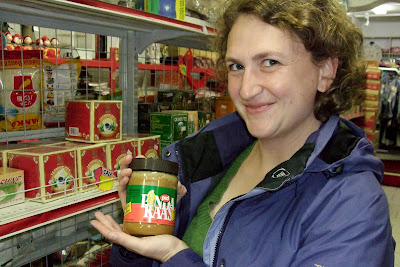Ah, Amsterdam! Because nothing says “family vacation” like a dildo shop next door to the hotel.
This weekend, my mom and I left the safety and rain of Nijmegen for the cultural treasures and rain of Amsterdam. I hate to admit it, but after ten months in the Netherlands, this was really my first time in Amsterdam proper.
A number of things surprised me about Amsterdam, but the most shocking was the number of people I saw wearing sweatpants.
You know: Amsterdam. City of canals and art and gays and ultra-progressive social policies like legalized prostitution and marijuana. And bleeding-edge fashion. Such as sweatpants. Regular, gray, straight-legged, American-style sweatpants.
We were also surprised by the sheer volume of artifacts just relating to the history of the city of Amsterdam. I acknowledge that the city is more than 400 years old, but seriously. There were a LOT of artifacts in a LOT of museums, all illustrating just three basic ideas:
- Guilds of men bearing crossbows policed the city and enjoyed having group portraits painted. Possibly more than they enjoyed actually firing their crossbows in defense of the city.
- Dutch trading companies made a tremendous amount of money building worldwide empires.
- The sanctioned flavor of Christianity changed every 50 years, but in the proud tradition of Dutch social tolerance, as long as you didn’t make a big fuss, you could pretty much worship however you wanted.

We visited many of Amsterdam’s signature museums, but we also hit some of its tiny specialty museums, of which there are also a shocking number.
Like the houseboat museum, which is a charming, houseboat-sized showcase of... (I know the suspense here is killing you) a houseboat.
We skipped the Bags & Purses Museum, as well as the Torture Museum. It’s debatable which of those would have actually been more torturous to visit.
Did I mention that it rained day and night?
I have to admit that my biggest concern about taking my mother to Amsterdam was not the pot or the Red Light District (though we partook of neither, in case you’re wondering).
It was the bicycles. She’s generally pretty alert, but if you haven’t spent the last ten months training yourself not to step into the path of speeding bicycles, the intermingling of bikes and pedestrian on the busy streets can be a little dicey.
Fortunately, the only true threat to my mother’s health and well being came when she dumped a sachet full of salt into her morning coffee. Needless to say, this was not a gentle introduction to the otherwise delightful Dutch buffet breakfast.
Me: Were those packets next to the coffee?
Her: No, but they were right next to the packets of brown sugar!
Me: Um...I think those were mustard seeds.
My mother, who has a long and storied culinary history of swapping salt in for sugar, tried to invoke the Vegas clause with respect to the salt incident.
But because what she actually proclaimed was, “What stays in Amsterdam, happens in Amsterdam.” said clause was null and void.
Sorry, Mom.
After Amsterdam, we ignored wretched weather forecasts (one of which actually used the term “wretched”) and took a train across the Flemish countryside to Bruges, a small Belgian city near the coast.
Lots of people had recommended Bruges as THE day trip to take from Nijmegen, but I was a little skeptical. How great could some obscure little Belgian city be?
As it turns out: really great!
In short, Bruges is a lovely, beautifully preserved medeival city with a strong but not overly commercialized tourist infrastructure. Plus: canals, museums, churches, restaurants, chocolate shops, cafes, and miles and miles of twisty little streets with gorgeous old (really old) houses. And a fully operational nunnery.
It’s a lot more interesting than it sounds.
I realize that this doesn’t really help my argument, but some people even call it “The Venice of Belgium.”
There’s not much going on in Bruges other than tourism associated with the places I mentioned above. Fortunately, we only experienced a few Disneyland moments.
Like one of the churches’ infinite-loop PA-system announcement inviting you in 7 languages to lay hands on its holy relic and thanking you in advance for your donation.
Or the bell towers, which really lay on the charm by chiming every 15 minutes. This is great, except that the first carillon tune we heard was “Stars & Stripes Forever.”
Nothing says “Medeival Capital of Europe” like John Philip Sousa!

Or the street musicians, who added lots of old world atmophere except when playing an accordian rendition of “My Way.”
The weather wasn’t wretched, after all, except for a driving rain that started the minute we stepped off the train.
After that, the clouds parted and coughed up some nice light for the 700 photos we took.
No trip to Belgium (or the Netherlands, for that matter) is complete without an order of friets.
Though I took pity on my mother and didn’t make her eat them with a big, delicious glop of mayonaise on top.























.jpg)






